Are drones allowed over water?

Drone Laws for Coastal Areas
Flying drones over coastal areas can be a thrilling experience, but it's crucial to understand the legal framework that governs such activities. In many countries, including the United States and Canada, the Federal Aviation Administration (FAA) and Transport Canada respectively regulate drone operations within their jurisdictions. These regulatory bodies have specific rules for flying drones near or over water.
One of the primary concerns is safety. Coastal areas often see high traffic from boats, swimmers, and other recreational activities, making it essential to maintain a safe distance from these potential hazards. Additionally, environmental protection laws may restrict drone operations in sensitive marine habitats.
Flying Drones Near Rivers & Streams
When flying drones near rivers and streams, pilots must adhere to local regulations that often vary by region. In the United States, for example, the FAA requires operators to maintain a minimum distance of 400 feet from any person or structure not under their control. This rule applies equally to waterways as it does to land.
Moreover, many states and municipalities have additional restrictions that may apply near rivers and streams. For instance, some areas might prohibit flying drones over certain protected wildlife habitats or during specific times of the year when migratory birds are present.
Is It Legal to Use Drones Over Seas?
Flying drones over seas presents unique challenges due to vast distances and potential risks associated with marine activities. The FAA has established guidelines for drone operations over open water, including requirements such as maintaining visual line-of-sight contact with the drone at all times.
International waters pose additional complexities since multiple jurisdictions may claim authority over different regions of the sea. Operators should consult international aviation authorities and maritime laws to ensure compliance when flying drones in these areas.
Can You Fly Drones Above Lakes?
Lakes offer a picturesque setting for drone photography, but operators must be aware of local regulations that may restrict such activities. In many cases, state or provincial parks have specific rules regarding drone use within their boundaries.
For example, the National Park Service in the United States prohibits drones from being flown over national park lands unless prior approval is granted by the superintendent. Similar restrictions exist in Canada and other countries where protected natural areas are concerned.
Waterway Drone Laws Explained
The legal landscape for flying drones near waterways can be complex, with various federal, state, and local regulations applying simultaneously. It's important to research specific rules applicable to the area you plan to fly over.
- Federal Regulations: The FAA in the United States and Transport Canada provide overarching guidelines for drone operations.
- State & Provincial Laws: Many states or provinces have additional regulations that may be more restrictive than federal rules.
- Municipal Ordinances: Local governments often impose their own restrictions, particularly in heavily populated areas near waterways.
Drone Regulations for Water Surfaces
Flying drones directly over water surfaces requires careful consideration of safety and legal issues. The FAA recommends keeping drones at least 30 meters (100 feet) away from any person or vessel not under the operator's control.
In addition to these guidelines, operators must be aware of environmental regulations that may restrict drone use in certain areas due to ecological concerns.
Are FPV Racing Drones Legal Over Water?
Flying first-person view (FPV) racing drones over water presents unique challenges and legal considerations. While the FAA permits recreational FPV flying, it is subject to strict safety guidelines, including maintaining visual line-of-sight contact.
The potential risks of losing control of an FPV drone over water are significant, making it essential for pilots to follow all applicable regulations and exercise extreme caution.
Drone Rules for Coastal Waters
Coastal waters present a unique set of challenges for drone operators due to the presence of marine traffic and environmental concerns. The FAA requires drones flown over coastal areas to maintain at least 400 feet from any person or vessel not under direct control.
In addition, local authorities may impose additional restrictions based on specific conditions in their jurisdiction, such as wildlife protection zones or busy shipping lanes.
Flying RC Drones Over Bodies of Water
Remote-controlled (RC) drones are subject to the same regulatory framework as other types of unmanned aircraft when flying over bodies of water. Operators must comply with federal and local regulations regarding distance from people, vessels, and protected areas.
It's important for RC drone enthusiasts to stay informed about any updates or changes in relevant laws that could affect their ability to fly legally.
Is It Legal to Fly Drones Near Rivers?
Flying drones near rivers involves adhering to a combination of federal and local regulations. The FAA mandates maintaining at least 400 feet from persons not under the operator's control, while states or municipalities may have additional restrictions.
Rivers often serve as natural boundaries between jurisdictions, so it’s crucial for operators to understand and comply with rules from all relevant authorities.
Can You Operate Drones Above Swamps?
Flying drones above swamps requires special consideration due to the unique environmental concerns of these ecosystems. Many states have specific regulations prohibiting drone use in wetlands or other sensitive habitats.
Operators must be aware of local wildlife protection laws and obtain any necessary permits before flying over such areas.
Conclusion
Flying drones over water presents both exciting opportunities and significant legal challenges. Operators must thoroughly research and comply with federal, state, provincial, and municipal regulations to ensure safe and lawful drone operations. By adhering to these guidelines, enthusiasts can enjoy the beauty of coastal areas, rivers, lakes, seas, and other bodies of water while respecting environmental and safety concerns.

